“AT THE END OF DECEMBER, I HEARD ABOUT A NEW VIRUS IN CHINA,” DR HUGH HEGGIE SAYS.
“STRAIGHT AWAY I STARTED WORRYING ABOUT WHAT HAPPENS IF IT COMES HERE?”
Almost six months on, Dr Heggie, the Chief Health Officer of the Northern Territory, is celebrating his 70th birthday.
But perhaps even more than his birthday, he’s celebrating how the NT survived the biggest crisis the world has seen since World War II. Coronavirus.

The virus has affected every single facet of life, in every single part of the world. And Dr Heggie’s job has been, and continues to be, to work out how to get the Territory through it in one piece.
“We are in uncharted territory,” Dr Heggie says.
“We saw a storm coming, we all got thrown into the water and we were going to drown with dying people around us.
“But, because of what we did in those early weeks, months, we survived.
“And now our job is to find land.”
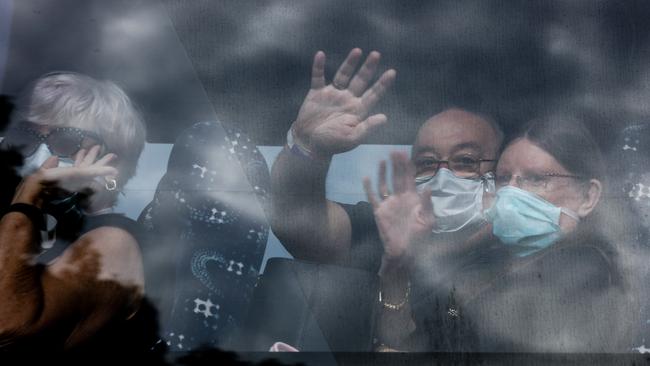
The NT was largely untouched by the virus until February, when Chief Minister Michael Gunner was asked by the Federal Government to take in hundreds of Australians who were evacuated from Wuhan and off the coronavirus-stricken Diamond Princess cruise ship. The incoming arrivals, the first group of whom touched down on February 20, caused anxiety that rippled through the Territory, as busloads of people impacted by this deadly new virus were being plonked right into our neighbourhood.
NT Health Minister Natasha Fyles says it was when these evacuees arrived to be isolated at the former Inpex workers camp in Howard Spring, that she realised just how dangerous the virus is.
“The Prime Minister asked the Chief Minister and of course we said yes, they’re Australians,” she says.
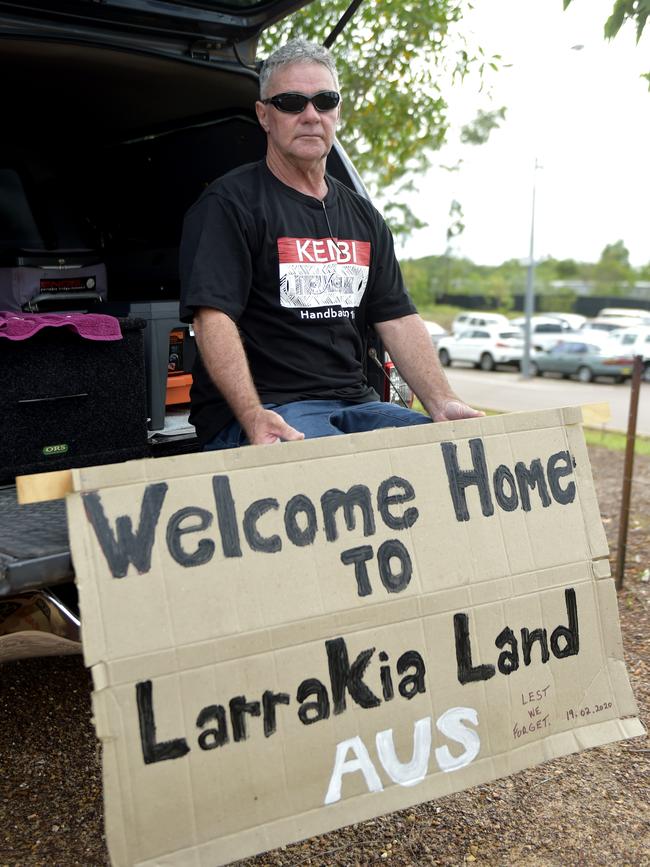
“Of course the community was anxious. It’s an unknown. We’d seen the stories from overseas, and that was bringing that to their homes.
“It really highlighted to the Territory how severe (the pandemic) was, so we had that sense of it early.”
But both Ms Fyles and Dr Heggie say it made sense for the Federal Government to turn to the NT in this time of crisis.
RELATED
NT’s early role as quarantine hub for Wuhan, Diamond Princess evacuees accelerated pandemic response
Domestic borders, including NT’s, should lift in July if ‘common sense prevails’: Prime Minister
Forced mandatory hotel quarantine for people coming to the Territory from interstate to be scrapped
Territorians know how to handle a crisis, and they know what it’s like to need the help of others.
“As Territorians we are used to disaster and we’ve been evacuees ourselves. The whole town was evacuated after Cyclone Tracy,” says Ms Fyles.
It was clear we had to help.
The NT didn’t see its own locally diagnosed case of COVID-19 for almost another month.
But then, inevitably, a 52-year-old tourist who had arrived from Sydney tested positive for the virus on the evening of March 4.

Panic set in through the community after it emerged he had checked into the Ramada Zen Quarter Hotel and shopped at the Woolworths in Darwin City before he began feeling unwell and then tested positive.
The NT’s team of leaders and scientists were trying to quell the mounting anxieties of the community, while also trying to stay above water themselves.
The man was quarantined and life went back to a relative normality.
But then, as the virus took hold in other parts of Australia and the world, more cases arrived in the Northern Territory.
Ms Fyles was fronting the media almost every day to announce that yet another case – or another group of cases – had been diagnosed.
By this point, everyone who crossed the border into the NT – either from interstate or overseas – was forced into quarantine for two weeks. And anyone with symptoms, who’d recently travelled, was tested.
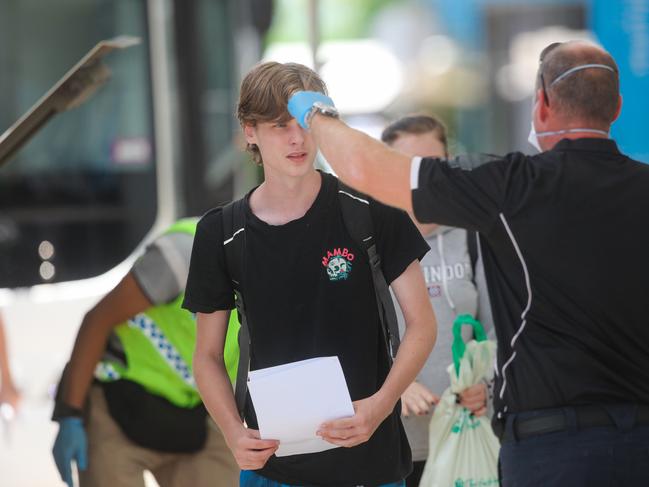
Events were being cancelled one after the other – some for the first time ever.
The Territory’s remote communities, which are home to some of our most vulnerable citizens, cut themselves off from the rest of the world.
Everyone agreed that if something like this made it into a community, the results would be nothing short of catastrophic.
And then, over a period of around 48 hours, everything changed.
On March 21, Mr Gunner announced he was following in the footsteps of Tasmania, and effectively closing the NT’s borders indefinitely.
“This is an unprecedented action for the Northern Territory,” he said during the announcement.
“But these are unprecedented times.”
The unprecedented times continued when, the very next day, Prime Minister Scott Morrison made another important announcement.
It was a Sunday night, and it was news that couldn’t wait until Monday.

Cafes, restaurants, bars, gyms and all non-essential indoor activities would be forced to close their doors from midday the next day.
Mr Gunner urged Territorians to keep supporting their local food joints. “Order some takeaway,” he said.
But, for some, it wasn’t enough.
First came the unemployment.
Then the thousands of people who spent their days standing in the unforgiving Territory sun in queues outside Centrelink offices. Many of them people with families, people who had never received government benefits before in their lives, people who had never expected they’d have to rely on the government for assistance.
When the numbers came in, they were dire.
Nearly 12,000 Territorians had lost their jobs.
Hospitality was hit the hardest, with a third of the jobs in the industry disappearing almost overnight.
Some venues closed temporarily. Some, including Darwin’s beloved Manoli’s Greek Taverna, closed permanently.
“What can you do, I think it won’t be the same once this is all over,” owner and head chef Manolis Papathomas said at the time.
“I think the whole economy is going to take a long time to get back on its feet.”
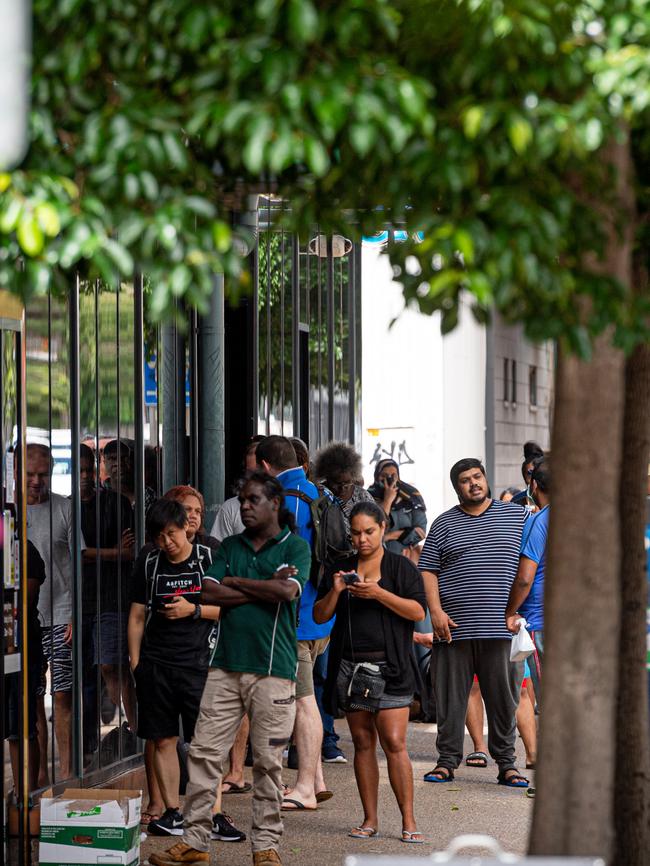
The economic hit was only compounded by the closed borders, and iconic tourist attraction Crocodylus Park was the next business to fall victim.
The park’s owner, Professor Grahame Webb, made the decision to close its doors for the first time in 26 years.
Chamber of Commerce chief executive Greg Ireland endured the ultimate baptism of fire – taking on the role just as the pandemic was engulfing the world.
And he was the one who business owners turned to as their livelihoods crumbled around them.
“We’re talking about peoples’ life savings, retirement disappearing,” he said.
“I certainly believe that when people get a chance to write the history (COVID-19) will be seen as the event with one of the most disruptive and devastating impacts.
“But, instead of a slow impact like a recession, where you get time to react along the way, it literally happened overnight.”
The new Territory cases of COVID-19 kept coming and they were cared for in specialised wards of the hospitals until they had made a full recovery.
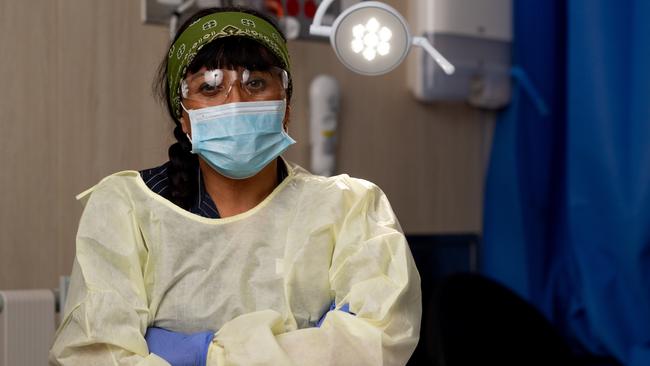
While the rest of the Territory was told to stay home, frontline health workers were on high alert, working around the clock to fight this virus they were still trying to understand.
One of those workers was clinical nurse manager Heni Hongara.
She had the unimaginable job of leading the team that came face-to-face with the virus every day.
“It was a very anxious time, given the world media was portraying a lot of death, a lot of uncertainty,” she said.
“They weren’t even sure what COVID was.”
COVID-19 was different to anything they had ever seen before, and even for seasoned frontline health workers, it was too much.
“I had maybe three staff who said: ‘I can’t come to work, I can’t do this. I have a baby at home, I can’t bring this thing home with me,’ ” Ms Hongara said.
A small team of doctors and nurses worked the wards day and night.
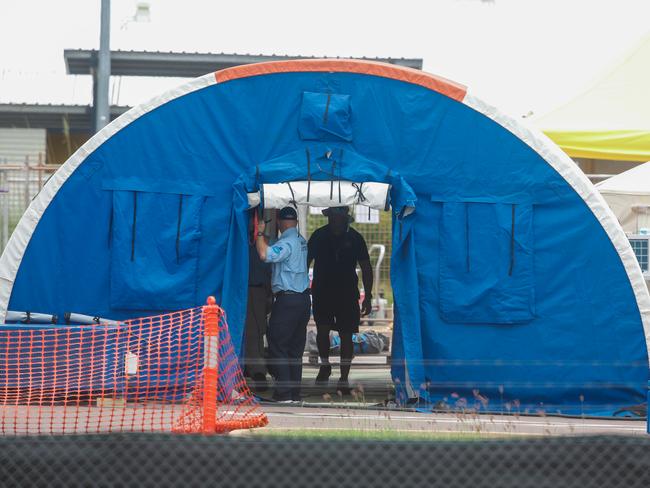
Doctors would sleep in a chair in the back room so the nurses always had the support they needed.
“I would go home thinking about it,” Ms Hongara said. “Wake up thinking about it.
“I was probably always thinking COVID.
“To be honest, I’m still thinking COVID.”
But then slowly ever so slowly, the clouds began to clear.
The number of cases began to dry up – 10, then five, then three.
Soldiers returning from duty in the Middle East were diagnosed and, like in February, the NT put up its hand to care for Australians in need.
But then, eventually, there were none.
Mr Gunner had a plan – the Territory would be one of the first places in the country, and indeed the world, to start getting back to normal.
On May 15, Territorians poured into pubs, cafes and restaurants as soon as the clock struck 12pm, as the first lot of restrictions were lifted.
On Friday, even more restrictions will lift. And the biosecurity restrictions stopping travel to remote communities and protecting our most vulnerable people will also go.
For many, the world is starting to feel normal again.

Sporting competitions will soon start, something NT Cricket chief executive Joel Morrison said would be a powerful tool for getting the community back together.
“I hope it really helps us value the contribution of community sport to the entire population,” he said.
AFL NT chief executive Stuart Totham added: “We’ve got a community that just loves Aussie rules.
“I think it is important that we’re positive about the future – things will be different but not all change will be bad.”
We have done well – almost better than anyone. But, ask anyone in charge and they will say we aren’t out of the woods yet.
Our Aboriginal people, in particular, remain particularly vulnerable to a second wave. And, it’s obvious we still have a lot to learn about including them in these important conversations.
“Everyone saw the importance of the Aboriginal leadership being part of the solution, and not the problem,” said Northern Land Council chief executive Marion Scrymgour.
“We are part of that solution going forward and we have to be.
“We’ve just got to get better and learn the lessons we’ve all learnt, I just hope government learns some of those lessons too.”
But, for our local businesses – especially the tourism sector – perhaps the biggest challenge is yet to come.

Territorians have staunchly supported the local economy, but as Mr Ireland said: “There’s only so many times you can go to Kakadu or do a harbour cruise.”
Mr Ireland said if we are to have any chance of bouncing back economically – despite how scary the prospect is – the borders need to reopen as soon as possible.
“There’s a massive opportunity for people who would normally go overseas for these upcoming school holidays and are now thinking about where they can go,” he said.
He, like Ms Scrymgour, said the Territory couldn’t go back to the way it was before, once this pandemic is behind us.
Get amazing Sennheiser earbuds (RRP: $499) with NT News subscription deal
“We have to come up with a significant way forwards. That’s a huge responsibility but without that we have risk of continuing the downward spiral,” Mr Ireland said.
It’s certainly an opportunity, and an opportunity not to be missed from an economic recovery perspective.
“We can’t afford to mess this up.”
When asked how Dr Heggie is feeling about the future, he pauses for a moment to consider. “I’m terrified but I’m confident,” he finally decided.
“Terrified, but confident.”

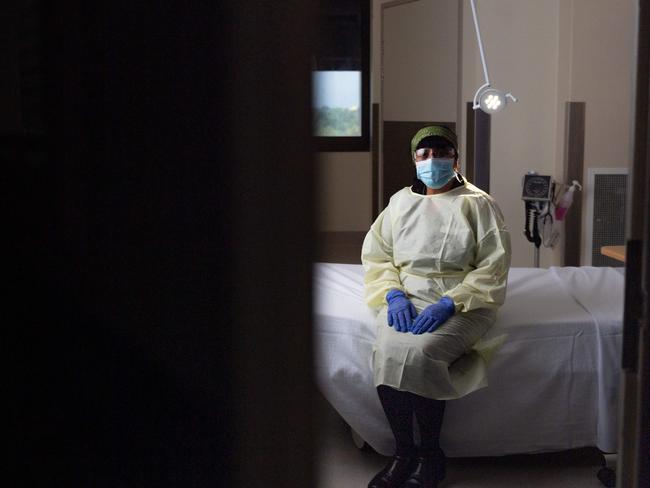
Add your comment to this story
To join the conversation, please log in. Don't have an account? Register
Join the conversation, you are commenting as Logout
Coming home for Christmas: Darwin man’s Leukaemia battle success
Darwin dentist Mathew Robertson was diagnosed with leukaemia and ended up spending last Christmas in a hospital bed. Now he’s made it through to the other side with a new lease on life.
Down the runway: Every look by Box Hill fashion students in 2024
From designs made out of recycled car parts to intricately woven corsets and breathtaking wedding dresses, here are all the designs by Box Hill Institute fashion students on the runway.